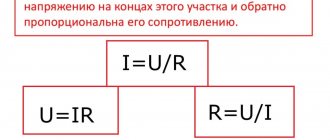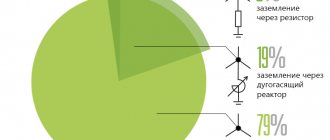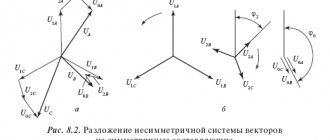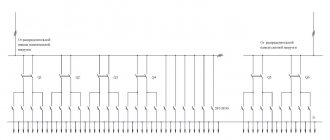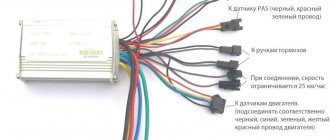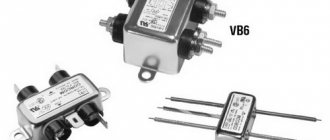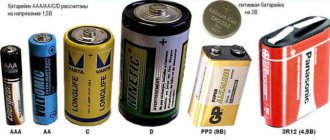The power supply system (SPS) combines sources, systems for conversion, transmission, and distribution of electricity. Electricity receivers (consumers) are not included in the SES. Power supply systems for industrial enterprises are based on electrical installations that are needed to provide consumers with electrical energy. The consumer can be an electrical receiver or another unit that converts electrical energy into another type of energy. There may also be several of these mechanisms. In this case, they are combined into one technological group and placed in a separate space.
The power supply of industrial enterprises is built on the basis of supply, distribution, transformer, converter substations, as well as on cable, overhead networks, and conductors (low and high voltage) connecting them. The design of power supply for industrial enterprises must take into account the most important requirements that determine:
- reliability;
- convenience;
- safety;
- ensuring the required quantity/quality of energy;
- uninterrupted supply of electrical energy in normal mode and after an emergency;
- cost-effectiveness of energy, materials and equipment.
It is possible to comply with the above requirements by using mutual redundancy of enterprise paths and consolidation of power supply to industrial and municipal (as well as rural) consumers. At the time of construction of an enterprise’s own power station, it is necessary to take into account nearby energy consumers (off-site).
Household voltage standard in the USSR until the 60s of the 20th century
In the USSR, until the 60s of the 20th century, 127 V was considered the standard for household voltage. This value owes its appearance to the talented engineer of Russian-Polish origin Mikhail Dolivo-Dobrovolsky, who at the end of the 19th century developed a three-phase system for the transmission and distribution of alternating current, different from the previously proposed Nikola Tesla - two-phase.
Initially, in Dobrovolsky’s three-phase system, the linear voltage (between two phase conductors) was 220 V. The phase voltage (between the neutral and phase conductors), which we use for domestic purposes, is less than the linear voltage by the “root of three” - accordingly, for this case we obtain the indicated 127 IN.
Power supply diagrams for industrial enterprises
The most reliable, economical power supply system is one in which the highest voltage sources are as close to consumers as possible, and the reception of electrical energy is distributed across all points. During the construction of a system, all its elements are formed under load. In this case, the “cold” reserve is not used. Thus, electrical energy losses are reduced and reliability increases. Why is this happening? Backup elements that have been inactive for a long time may not work when turned on due to a faulty condition. In order to avoid the consequences of this situation, the scheme provides for a “hidden” reserve, which in a post-emergency state will be able to take on the main load of the non-working element.
Resumption of power supply to consumers occurs automatically using alternating operating current. In this case, faulty consumers are automatically switched off for the post-emergency period. By the way, separate operation of elements is often successfully used. In this case, the short-circuit current is reduced and switching is simplified.
Automation ensures reliable power supply in separate operation. The quality of power supply is no worse than with parallel operation. Partitioning of all elements with ATS circuits (automatic switching on of a reserve) is used. This method helps to increase the reliability of power supply. Unfortunately, not in all cases, separate work with ATS shows the desired result. It is not always possible to achieve a quick system recovery.
Electrical supply diagrams are formed in stages, which indicate the power of the enterprise and the location of electrical loads. Most often, 2-3 stages are used. If there are more of them, then protection, operation, and switching become more complicated. Such schemes are applicable in peripheral areas, on individual transformers.
Single-stage schemes are used in small and medium-sized enterprises, applied to:
- main, radial lines of deep wires 110-220 kV - power more than 50 MV-A;
- main, radial current conductors 6-10 kV - power more than 15-80 MV-A;
- trunk, radial cable networks 6-10 kV - power 15-20 MV-A.
Schemes with deeper inputs and main current conductors require compliance with certain points. For example, if it is possible to easily implement the principle of splitting substations and deep 110 kV inputs, then there is no need to use conductors. In the event that the location of a considerable number of 35-220 kV substations, and the passage of overhead lines of deep inputs is difficult, then current conductors are used. Based on these calculations, the final decision on constructing the circuit can be made.
The USSR is moving to a new standard - 220/380 V
In the Soviet Union, despite the presence of a progressive 220/380 V standard, when implementing the mass electrification plan, AC networks were built mainly using outdated methods - 127/220 V. The first attempts to switch to European-style voltage were made in our country back in the 30s. x years of the XX century. However, the massive transition began only in the post-war period; it was caused by the increasing load on the power system, which forced engineers to choose - either increase the thickness of the cable lines or increase the rated voltage. In the end, we settled on the second option. A certain role in this was played not only by the factor of saving materials, but also by the involvement of German specialists who had applied experience in the use of electrical energy with a voltage of 220/380 V.
The transition lasted for decades: new substations were built with a rating of 220/380 V, and most of the old ones were transferred only after the planned replacement of outdated transformers. Therefore, in the USSR, for a long time, two standards for public networks coexisted in parallel - 127/220 V and 220/380 V. The final switch to 220 V of some single-phase consumers, according to eyewitnesses, occurred only in the late 80s - early 90s .
Receivers providing power supply to industrial facilities
- 1 Receivers providing power supply to industrial facilities
- 2 Power supply of industrial buildings. Voltage
- 3 Power supply diagrams for industrial enterprises
- 4 Power supply to industrial enterprises and installations in unfavorable climatic conditions
Since electrical networks and substations are elements of the overall structure of the enterprise, they must be coordinated with technological and construction parts, as well as with the building plan. For example, large enterprises of non-ferrous and ferrous metallurgy have high requirements for reliable and high-quality power supply. They are distinguished by high values of the total installed power of electrical receivers, which can reach 1700-2000 MW.
Electrical receivers can be divided into 3 categories:
1. Electrical receivers that, due to interruptions in power supply, may pose a danger to people, cause damage to equipment, products, etc. Such receivers must be powered from two separate sources. An interruption in power supply is possible only for the period of automatic switching on of the reserve. Examples: production steam boiler houses, blast furnace shops, cupola drives, critical pumping stations, casting cranes, etc.
2. Electrical receivers, interruption in operation of which is associated with undersupply of products, downtime of workers, machinery, and transport. Power interruptions are acceptable for the time required to manually switch on the reserve.
3. Other electrical receivers that are allowed to have a power supply interruption for the duration of repairs (no more than one day). For example, auxiliary workshops, non-critical warehouses, non-serial production workshops, etc.
In order to correctly solve reliability issues, it is necessary to accurately establish the modes that arise during an accident and after it. Emergency mode is a temporary mode that occurs due to a disruption in the acceptable operation of the power supply system or its individual elements. Post-emergency mode is a mode after the elimination of an accident, which lasts until normal operation is completely restored.
It is obvious that the power supply system must be built in such a way that, in a post-emergency mode, it can ensure the functioning of the main production facilities of an industrial enterprise (after the necessary reconnections). In post-emergency mode, interruptions in the power supply to receivers of the third and partly second categories are allowed for a short time.
Power supply to industrial enterprises and installations in unfavorable climatic conditions
Most enterprises have contaminated areas that arise due to the formation of harmful substances. They negatively affect current-carrying elements of electrical installations. Sources of pollution are chemical, ferroalloy production, as well as production of steel, magnesium, etc. Such pollution has five degrees (the first degree is the most powerful).
For contaminated areas, special standards are established to determine the type of insulation, substations, and power lines. The minimum gaps from pollution sources are also calculated. The distance depends on the production class. For example, for the fifth degree - from fifty meters, for the first - up to 1500 meters.
The problem of pollution requires special attention and necessary measures.
In which countries besides the USA is the 100 - 127 V standard common?
Here is a list of countries where 100–127 V networks are used. This is worth considering if you are planning to go on vacation abroad.
| A country | Voltage, V |
| Samoa | 120 |
| Anguilla | 110 |
| Aruba | 127 |
| Bahamas | 120 |
| Barbados | 110 |
| Belize | 120 |
| Bermuda | 120 |
| Bonaire | 127 |
| Brazil | 127 |
| Venezuela | 120 |
| Virgin Islands | 110 |
| Haiti | 110 |
| Guatemala | 120 |
| Honduras | 110 |
| Guam | 110 |
| Dominican Republic | 110 |
| Cayman Islands | 120 |
| Canada | 110 |
| Taiwan | 110 |
| Colombia | 120 |
| Costa Rica | 120 |
| Cuba | 110 |
| Liberia | 110 |
| Libya | 127 |
| Madagascar | 127 |
| Morocco | 127 |
| Mexico | 127 |
| Micronesia | 120 |
| Antilles | 127 |
| Nicaragua | 120 |
| Panama | 110 |
| Puerto Rico | 120 |
| Salvador | 115 |
| Saudi Arabia | 127 |
| Saint Kitts and Nevis | 110 |
| Suriname | 127 |
| Tahiti | 110 |
| Trinidad and Tobago | 115 |
| Ecuador | 120 |
| Jamaica | 110 |
| Japan | 100 |
As you can see, there are not many countries where the voltage is 100–127 V.
Electrical current
Once upon a time as a child, my father bought me my first tester TL-4M. I measured everything until a “brilliant” idea came to my head - to measure the current in the socket. As a result, the plugs were knocked out, the shunt burned out in the tester, and I realized that the current is always measured only through the load. Since then, the means of measuring current have made great strides forward, and for this purpose only current clamps are used (transformer method), shunts are practically not used.
The current, more precisely, its value, shape and components, depends significantly on the load. For example, here is what the voltage and current waveform looks like when the dimmer is operating:
Mains voltage and current THROUGH the dimmer
Naturally, current and voltage harmonics are present. Harmonics talk about how voltage and current waveforms differ from sinusoidal ones.
Voltage and current harmonics
Voltage and current harmonics can be seen in graphical form, both in the screenshot above and in table form - from the 1st to the 50th harmonics. For both single-phase and three-phase networks.
Electricity industrial, static and atmospheric
All topics in this section:
Basic principles of state policy in the field of labor protection State policy in the field of labor protection is based on the principles: (8 principles STR-278 (scientific commentary) art. 4.) 1st principle - priority g
State financing of occupational safety measures · funds for the training of occupational safety specialists · scientific development · maintenance of the National Research Institute of Occupational Safety · maintenance of the network of government agencies
The rights of workers to occupational safety while working at an enterprise The Law “On Labor Protection” stipulates that each employee at the workplace is guaranteed in accordance with the requirements of regulations on occupational safety: · safety of technological processes
Benefits and compensation for difficult working conditions Employees engaged in work with difficult and harmful working conditions in the manner prescribed by law have the following benefits: · are provided with free medical and preventive
Labor protection of women and minors It is prohibited to use women's labor in heavy work and in work with harmful or dangerous working conditions, in underground work, except for some underground work (non-physical or sled work).
Management bodies of occupational safety in Ukraine State management of occupational safety is carried out by: · the Cabinet of Ministers of Ukraine (under the Cabinet of Ministers of Ukraine there is a National Council for the Safe Life of the Population); · Sovereign
Responsibility for violation of labor and occupational safety legislation According to Articles 18, 19 of the Law “On Labor Protection”, the employee is obliged to: · know and comply with the requirements of regulations on occupational safety; · know the rules and instructions for handling machines
Noise protection Noise is a disorderly combination of sounds of different levels and frequencies in the work area. Noise affects not only the hearing aid, but also causes disorders of the cardiovascular and nervous systems,
Protection from dust To protect the respiratory organs of workers from dust in the work area at industrial enterprises, the following measures are taken: · the air in the work area is cleaned by mechanical ventilation;
Combustion of a substance and methods of extinguishing it Types of combustion: explosion, flash, ignition, smoldering, self-ignition, combustion. By origin, fires are divided into: exogenous, arising from an external heat source (open
The concept of fire resistance Fire resistance is the ability of a structure or material to retard the spread of fire (fire), temperature, expressed in time (in hours). Buildings and structures are divided into five degrees of fire resistance
Electrical burns Electrical burns can be superficial or internal. Superficial burns - affect the skin. Internal burns - affect deep-lying organs and tissues of the body. By the mustache
Environmental factors Unfavorable environmental factors include industrial premises, open or outdoor electrical installations in the open air. Production premises by degree of danger
Personal protective equipment in electrical installations When operating electrical installations, to prevent electrical injuries, special personal protective equipment is used, which is divided into primary and auxiliary. Fixed assets
Warning notices, posters, devices Electrical protective equipment also includes warning portable posters and notices, which have their own specifics. Their purpose is to draw the attention of workers to immediate danger,
Prohibitory inscriptions and posters Poster size - 240 × 130 mm. Red letters on a white background. Contents of the inscriptions: “Do not turn on - people are working”, “Do not open - people are working”, “Do not turn on - people are working”
Grounding and protective grounding To protect people from electric shock due to insulation damage in a network with an isolated neutral and the transition of voltage up to 1000V to conductive parts of equipment, machines, machinery
Rules of behavior during a thunderstorm A person during a thunderstorm can be at work, on the street, at home, in the forest, in the field. In production, all buildings, structures, power lines, radios, communications are equipped with lightning devices
Ventilation and air condensation According to their purpose, ventilation and condensation systems are divided into working and emergency. Working ventilation is one that constantly creates the necessary meteorological
Annual medical examinations of minors To prevent occupational diseases - the normal development of youth, labor protection legislation establishes preliminary and periodic medical examinations. For persons under 18
Basics of Human Anatomy Every person should know the structure and functions of the body (anatomy and physiology). Anatomy (from Greek - dissection) studies the structure of the human body, its organs, tissues, and cells.
Basic quantitative indicators of the human body Blood volume: · for men - 5 liters; · for women - 4 liters. Heart rate: · 60-80 beats per minute. Blood pressure (ages 18-45):
First aid in case of electric shock The victim must be: · freed from live parts as quickly as possible; · quickly turn off the voltage with a switch or circuit breaker; · for release from live wires
Revival by methods of artificial respiration, indirect cardiac massage. The figure shows the correct position of the hands when performing external cardiac massage and determining the pulse in the carotid artery (dotted line).
Indirect (closed) cardiac massage External cardiac massage. If there is not only breathing, but also a pulse in the carotid artery, artificial respiration alone is not enough when providing assistance, since oxygen from the lungs cannot be transferred
Frequency
Everyone knows that the frequency of the supply voltage in our outlet is 50 Hz. This means that everything is repeated 50 times per second. In other words, the duration of the voltage period is 20 ms. More precisely, according to GOST 29322-2014, the voltage frequency should be 50±0.2 Hz. That is, from 49.8 to 50.2 Hz.
Perhaps frequency is the only parameter that is not affected by anything. And its stability depends only on the operation of the power plant. This is what the frequency graph looks like on the screen of a power quality analyzer:
Mains frequency
The graph shows that the frequency deviates by no more than 0.03 Hz from the nominal value, which is within GOST standards by a large margin.

